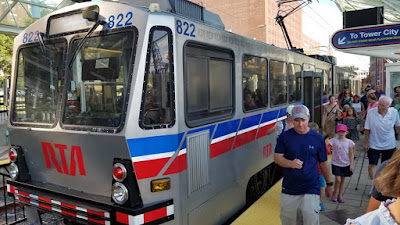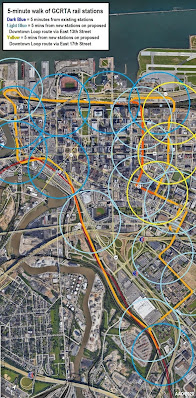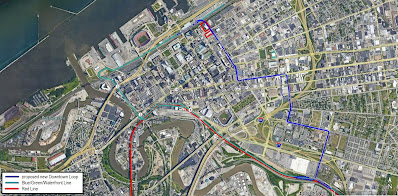 |
| The Greater Cleveland Regional Transit Authority’s Flats East Bank Station in Downtown Cleveland (AAO). |
Think of the benefits Clevelanders could see by morphing GCRTA’s low-ridership light-rail Waterfront Line from dead-ending in a windswept, out-of-the-way parking lot into a fully functional and convenient Downtown Loop that serves more of downtown Cleveland’s most important destinations.
Imagine a one-seat ride on the Rapid in any weather from the eastern suburbs to Cleveland State University in 30 minutes or less without worrying about parking or traffic.
Or, traveling from your home on the West Side to Tri-C Metro without having to transfer to another transit vehicle or walk 20 minutes from the nearest station.
Or, riding from your apartment on Playhouse Square to Little Italy or the Van Aken District to enjoy dinner with friends and family.
Or, being able to live, get to work, do your day-to-day errands, and socialize all within a short walk of new, fare-free Orange Line trains operating every few minutes on the Downtown Loop, whether you live in an affordable apartment at Sankofa Village or a penthouse condo overlooking Cleveland’s lakefront.
 |
| Nearly all of Downtown Cleve- land would be within a 5-minute walk of a Rapid rail station with a Downtown Loop (AAO). |
This week, Stu Nicholson, executive director of the nonprofit rail and transit advocacy organization All Aboard Ohio, sent a letter to Greater Cleveland Regional Transit Authority General Manager India Birdsong and the agency’s Board of Directors. In it, he asked GCRTA to consider reviewing options for the future of the Waterfront Line.
These options could include continuing the status quo, abandoning the line, pursuing limited enhancements such as fare-free service or expanding the line such as along the eastern lake shore or, preferably, as a Downtown Loop. These reviews could be included as part of GCRTA’s ongoing Next Gen system planning and 2030 Strategic Planning processes.
Indeed, this low ridership that began pre-pandemic raises questions about the future viability of this rail infrastructure and service, Nicholson wrote in his Nov. 30 letter. “We believe those questions should be the subject of a careful review by GCRTA and its downtown stakeholders.”
When the Waterfront Line opened in 1996, it was intended to eventually go someplace beyond the municipal parking lot on the East Shoreway. In 2000, GCRTA concluded a Major Investment Study called Waterfront Line Phase II.
The study showed that expanding the 2.2-mile Waterfront extension of the Blue and Green lines (Shaker Heights Tower City) as a Downtown Loop could produce enough ridership at relatively low costs to justify federal construction funds.
In 2000, the Federal Transit Administration looked favorably on transit expansions that had a cost per new rider lower than $20. The Downtown Loop was estimated at a cost per new rider of less than $14.
That was before Downtown Cleveland increased its residential population by more than 100 percent, saw downtown employers grow with more than $7.25 billion worth of investment, and attracted new corporate offices from the suburbs and other metro areas, Nicholson said. And it was well before GCRTA considered replacing its rail fleet with a standard rail car that can travel on any of its five lines, plus future ones.
There are many reasons why GCRTA should consider expanding the Waterfront Line, possibly as a Downtown Loop:
- Continuing the Waterfront Line as-is cannot endure. It has limited value beyond handling crowds for special events along the downtown waterfronts.
- Abandoning the Waterfront Line will require GCRTA to reimburse the Federal Transit Administration up to $10 million for state-of-good-repair improvements made to the line since 2010.
- Only about one-third of the Central Business District is within a 5-minute walk of an existing GCRTA rail station. A Downtown Loop routed via East 17th could put nearly two-thirds of the CBD within a 5-mile walk. A Downtown Loop routed via East 13th could put up to 90 percent of the CBD within a 5-minute walk.
- In 2000, the Downtown Loop was projected to attract 2.2 million square feet of nonresidential development, nearly 1,000 housing units, $441 million in overall development (in 2000$), nearly 9,000 permanent jobs, $250 million in new payroll and $17.8 million in new local tax revenues per year.
- Those benefits offer the potential for GCRTA to fund the local share of the Downtown Loop from short-term tax-increment financing. The rest could come from the federal government which is likely to become more transit-friendly under the Biden-Harris Administration.
- GCRTA is considering replacing its 35- to 40-year-old rail fleet with standard light-rail trains that can operate on any line in its rail system, including any future line expansions like a Downtown Loop.
- Chicago-based Akara Partners plans a huge expansion of the Flats East Bank community starting early in 2021 with up to 2,000 housing units, tens of thousands of square feet of co-working office spaces and neighborhood-oriented retail.
- Cuyahoga Metropolitan Housing Authority is replacing the obsolete Cedar Extension Estates with the mixed-income, mixed-use Central Choice Neighborhood (Sankofa Village, Cleveland Scholar House) – a large-scale, mixed-use project on 15 acres with nearly 400 apartments and townhouses at full buildout.
- Cleveland State University is about to begin a campus master plan process, focusing on redevelopment of the Wolstein Center site, additional housing and transportation access.
- The Cleveland Metroparks is leading the Cleveland Harbor Eastern Embayment Resilience Study (CHEERS) with a new land use vision for the shoreline east of downtown.
- In 2017, FirstEnergy’s Lake Shore Power Station was demolished, offering lakefront development and recreational opportunities that preceded the city’s last lakefront plan update in 2004 in which the city proposed extending the Waterfront Line to near Bratenahl.
GCRTA should consider expanding the Waterfront Line, as originally intended, to reach important destinations in and near Downtown Cleveland, Nicholson said. Continuing the status quo is the only option GCRTA should not be embrace.
This is a reprint of an All Aboard Ohio press release available HERE.
END











